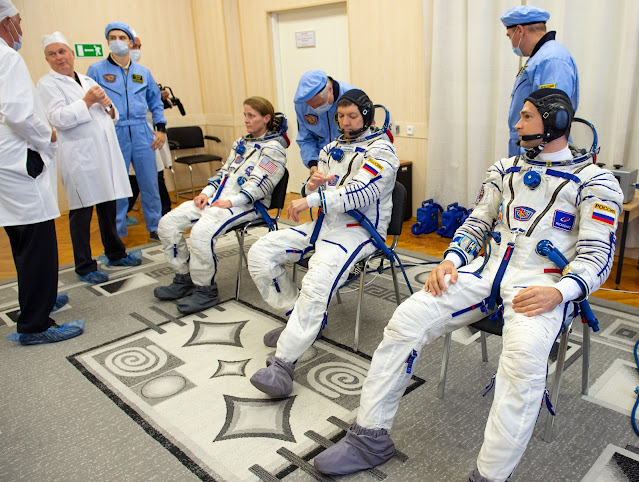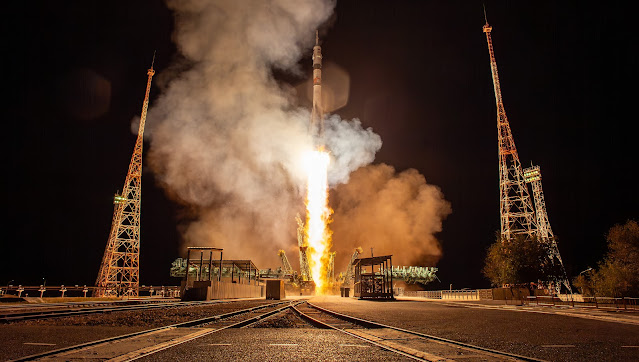NASA Astronaut Tracy Dyson Receives 3rd International Space Station Assignment
NASA astronaut Tracy Caldwell Dyson Official Portrait 2023
Expedition 23 NASA Flight Engineer Tracy Caldwell Dyson of the U.S. in her Russian Sokol suit
Expedition 24 Flight Engineer Tracy Caldwell Dyson shakes hands with former NASA Astronaut and Chief of the Astronaut Office Peggy Whitson shortly after landing in the Soyuz TMA-18 spacecraft.
NASA astronaut Tracy Caldwell Dyson pauses for a portrait while donning her spacesuit and before going under water in the Neutral Buoyancy Lab at Johnson Space Center
NASA astronaut Tracy Caldwell Dyson Official Portrait 2010
NASA has assigned astronaut Tracy C. Dyson to her second long-duration mission to the International Space Station as a flight engineer and member of the Expedition 70/71 crew. Dyson will launch on the Roscosmos Soyuz MS-25 spacecraft in March 2024 and spend approximately six months aboard the International Space Station. She will travel to the station with Roscosmos cosmonaut Oleg Novitskiy and spaceflight participant Marina Vasilevskaya of Belarus, both of whom will spend approximately 12 days aboard the orbital complex.
Astronaut Tracy Caldwell Dyson Official NASA Biography:
During her expedition, Dyson will conduct scientific investigations and technology demonstrations that help prepare humans for future space missions and benefit people on Earth. Among some of the hundreds of experiments ongoing during her mission, Dyson will continue to study how fire spreads and behaves in space with the Combustion Integrated Rack, as well as contribute to the long-running Crew Earth Observations study by photographing Earth to better understand how our planet is changing over time.
After completing her expedition, Dyson will return to Earth in fall 2024 with Roscosmos cosmonauts Oleg Kononenko and Nikolai Chub on the Soyuz MS-25 spacecraft. Kononenko and Chub launched Friday, Sept. 15, 2023, with NASA astronaut Loral O’Hara on the Soyuz MS-24 spacecraft. Kononenko and Chub will remain aboard the orbital laboratory for about one year. O’Hara, who will spend six months aboard the space station, will return with Novitskiy and Vasilevskaya on the Soyuz MS-24 spacecraft.
NASA selected Dyson as an astronaut in June 1998, and during her previous two flights, logged more than 188 days in space. Dyson first launched aboard the space shuttle Endeavour on STS-118 in 2007, serving as a mission specialist. During the mission, the crew successfully added the starboard-5 truss segment to the station’s “backbone” and a new gyroscope. In 2010, she served as flight engineer for Expedition 23/24 and performed three successful contingency spacewalks, logging 22 hours and 49 minutes outside the station as she helped remove and replace a failed pump module for one of two external ammonia circulation loops that keep internal and external equipment cool.
Dyson has worked inside the Mission Control Center at NASA’s Johnson Space Center in Houston as spacecraft communicator, known as capcom, for both space shuttle and space station operations. She also served as the lead capcom for various space station missions, as well as the development of the capcom cadre for Boeing’s Starliner Mission Operations Team. Other technical assignments included leading the development of the spacewalk qualification training flow, which she helped to complete for the 2017 class of NASA astronauts.
Born in Arcadia, California, Dyson received a Bachelor of Science degree in chemistry from California State University, Fullerton, in 1993, and a doctorate in chemistry from the University of California, Davis, in 1997.
For more than 22 years, humans have continuously lived and worked aboard the International Space Station, advancing scientific knowledge, and demonstrating new technologies, making research breakthroughs not possible on Earth. As a global endeavor, 244 people from 19 countries have visited the unique microgravity laboratory that has hosted more than 3,000 research and educational investigations from researchers in 108 countries and areas.
Learn more about International Space Station research and operations at:
https://www.nasa.gov/station
Credit: NASA's Johnson Space Center (JSC)
Release Date: Sept. 15, 2023
#NASA #Space #ISS #Science #Astronaut #TracyDyson #TracyCaldwellDyson #Chemist #Scientist #Researcher #Leader #SpaceflightVeteran #SoyuzRocket #BaikonurCosmodrome #Kazakhstan #Russia #Россия #Roscosmos #Роскосмос #Cosmonauts #Expedition70 #Expedition71 #HumanSpaceflight #JSC #UnitedStates #InternationaCooperation #STEM #Education


































.jpg)








.jpg)





